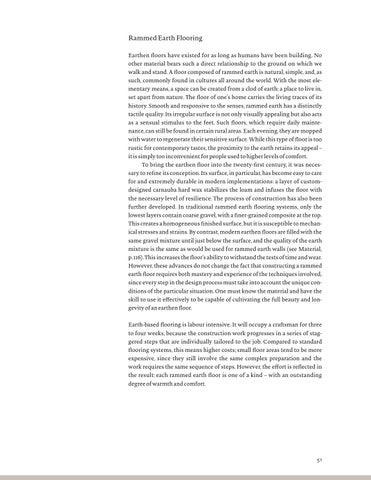Rammed Earth Flooring Earthen floors have existed for as long as humans have been building. No other material bears such a direct relationship to the ground on which we walk and stand. A floor composed of rammed earth is natural, simple, and, as such, commonly found in cultures all around the world. With the most elementary means, a space can be created from a clod of earth: a place to live in, set apart from nature. The floor of one’s home carries the living traces of its history. Smooth and responsive to the senses, rammed earth has a distinctly tactile quality. Its irregular surface is not only visually appealing but also acts as a sensual stimulus to the feet. Such floors, which require daily maintenance, can still be found in certain rural areas. Each evening, they are mopped with water to regenerate their sensitive surface. While this type of floor is too rustic for contemporary tastes, the proximity to the earth retains its appeal – it is simply too inconvenient for people used to higher levels of comfort.
To bring the earthen floor into the twenty-first century, it was neces-
sary to refine its conception. Its surface, in particular, has become easy to care for and extremely durable in modern implementations: a layer of customdesigned carnauba hard wax stabilizes the loam and infuses the floor with the necessary level of resilience. The process of construction has also been further developed. In traditional rammed earth flooring systems, only the lowest layers contain coarse gravel, with a finer-grained composite at the top. This creates a homogeneous finished surface, but it is susceptible to mechanical stresses and strains. By contrast, modern earthen floors are filled with the same gravel mixture until just below the surface, and the quality of the earth mixture is the same as would be used for rammed earth walls (see Material, p. 116). This increases the floor’s ability to withstand the tests of time and wear. However, these advances do not change the fact that constructing a rammed earth floor requires both mastery and experience of the techniques involved, since every step in the design process must take into account the unique conditions of the particular situation. One must know the material and have the skill to use it effectively to be capable of cultivating the full beauty and longevity of an earthen floor. Earth-based flooring is labour intensive. It will occupy a craftsman for three to four weeks, because the construction work progresses in a series of staggered steps that are individually tailored to the job. Compared to standard flooring systems, this means higher costs; small floor areas tend to be more expensive, since they still involve the same complex preparation and the work requires the same sequence of steps. However, the effort is reflected in the result: each rammed earth floor is one of a kind – with an outstanding degree of warmth and comfort.
51
